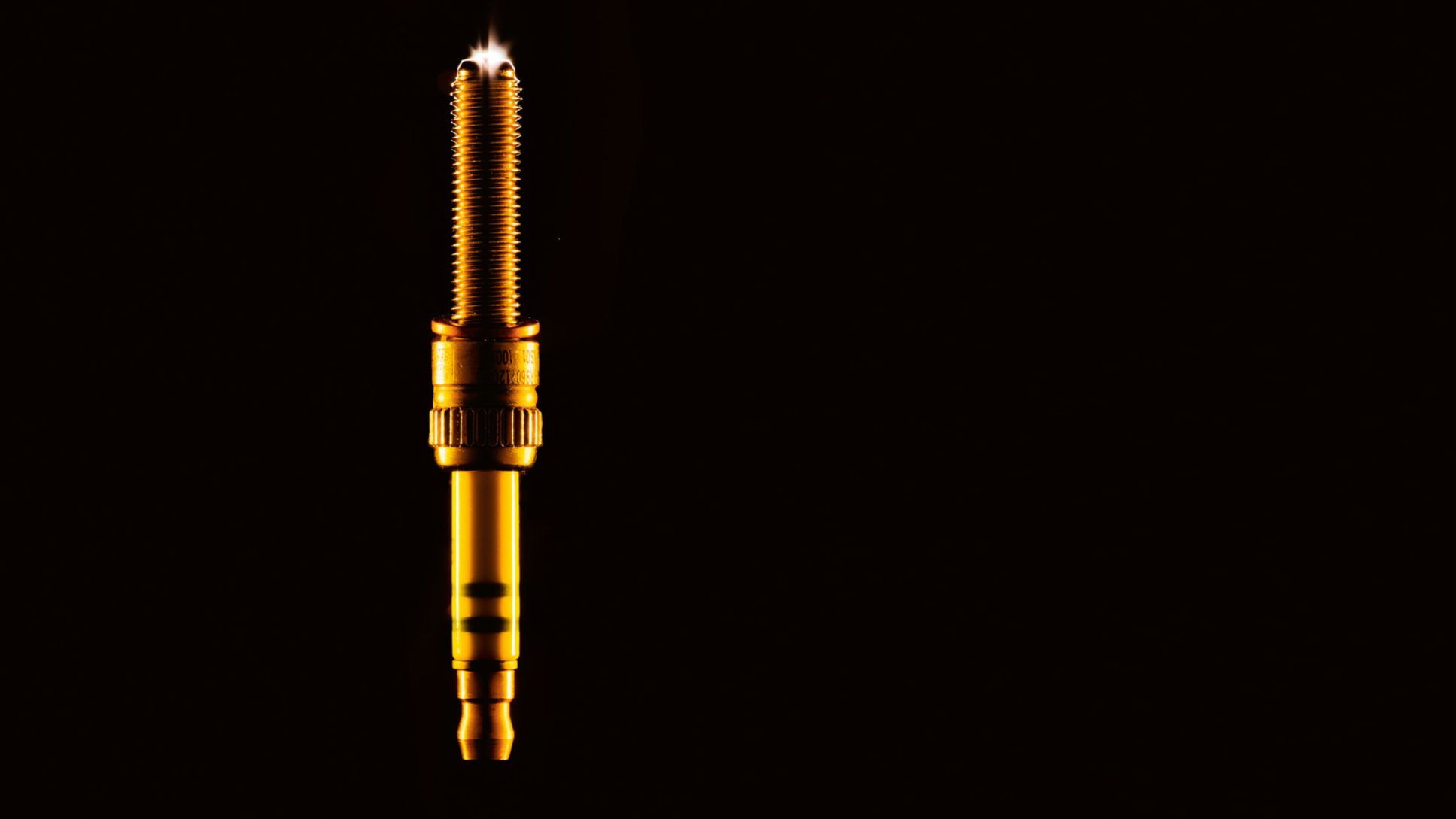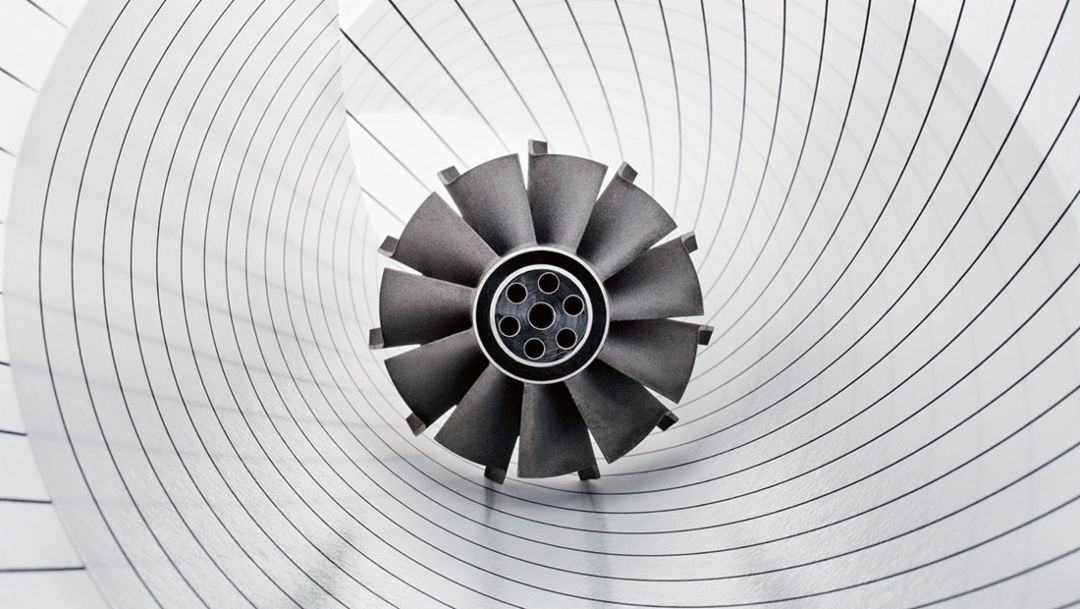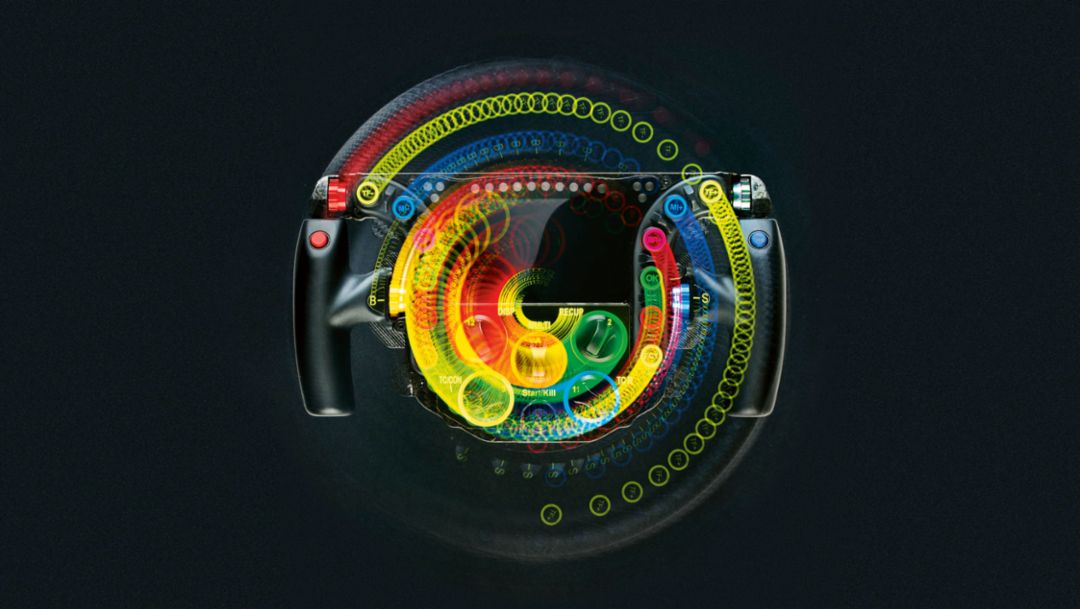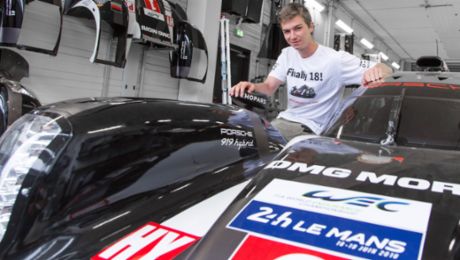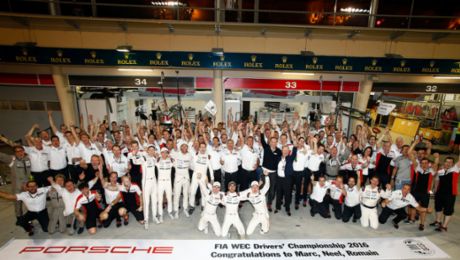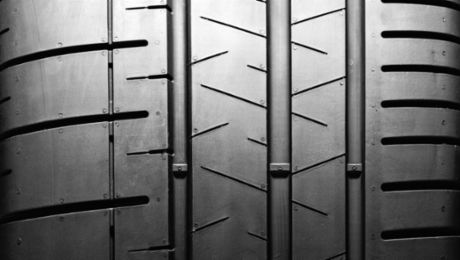An engine control unit and a chassis control unit control the interaction of all drive components in the 919 Hybrid, including the combustion engine and the exhaust energy recuperation in the rear and the electric motor on the front axle. Together, they are orchestrated by the dual electronic computer heart in such a way that the intelligent control of the all-wheel-drive system achieves maximum efficiency and the best-possible lap times. By means of the three-dimensional track profiles, every conceivable driving condition is simulated and optimized before the races. The control units take this information and translate the operation of the drive components into a perfectly harmonized interaction at all times. One additional requirement in the development of the high-performance computers is extremely lightweight construction.
For the hybrid system in the 919, Porsche opted for a high-voltage setup from the outset: 800 volts. It was not easy to find suitable components. For the storage medium, the engineers opted for a liquid-cooled lithium-ion battery cell used exclusively by Porsche.One of the race car’s batteries consists of hundreds of these cells. They feature a high power density—so they charge and can discharge energy quickly—but also a good energy density, that is, a high storage capacity. In battery cell development, new materials to further enhance the power and energy density are being tested all the time. In this way, Porsche is also the front-runner in developing technologies that will be used in future series applications in the field of electric and hybrid vehicles.
A paltry 1.1 pounds weighs a side mirror
If left to their own devices, aerodynamics engineers would prefer to do without airflow-disturbing protuberances altogether. For the drivers they are anything but superfluous, however, and for safety reasons the rules provide some parameters: they must have at least 15.5 square inches of mirror surface and be designed in such a way that the driver can see all cars more than 32 feet behind him while seated in his normal sitting position. Track marshals check the mirrors with alphabet boards to ensure that all is as it should be. Another requirement is the day/night setting—a light-sensitive film reduces glare from pursuers. The mirror surface itself is a thin glass layer adhered to a carbon substrate. The housing of the mirror is aerodynamically optimized to minimize wind resistance as well as vibrations. The mirrors and the adjustment mechanism are housed in a carbon-fiber composite shell. Altogether, the whole setup weighs a paltry 1.1 pounds.
The Porsche 919 Hybrid is the only prototype in the entire FIA World Endurance Championship field that not only recuperates energy and converts it into electric current during the braking process, but also has the ability to do so every time it accelerates. To make that possible, there is a small turbine installed in the exhaust tract; this turbine drives a generator with more than 120,000 revolutions per minute. The electricity thus generated is—like the electricity generated by the front-axle braking energy—stored in a lithium-ion battery. Once there, the driver can apply the additional energy at the touch of a button. To adapt the turbine to the different conditions, it is built with variable turbine geometry (VTG). Thanks to this VTG technology—the variable adaptation of the turbine geometry to the level of the exhaust pressure—the turbine can be driven even at low engine speeds and thus low exhaust pressures.
The entire two-liter, four-cylinderturbo gas engine in the 919 Hybrid is the most efficient combustion engine ever built by Porsche. The power unit with direct fuel injection must withstand the most extreme loads. The maximum engine speed is 9,000 rpm. Even the tiniest of components is maximally optimized in terms of performance and robustness—in spite of extreme lightweight construction. That applies to the spark plug as well, which has to withstand pressures that otherwise occur only in diesel engines. Impressive figures: at the high point of the 2016 season, the 24 Hours of Le Mans, each spark plug in the victorious 919 Hybrid reliably ignited the fuel–air mixture more than five million times. The spark plug is a custom development. It is much smaller and lighter than any series counterpart.
Pit stops have to be fast and safe. The rules prescribe the design of the tank system and tank nozzle. Fuel cannot spill during the fueling process or when removing the nozzle—the fuel would immediately ignite upon contact with the hot race car. The safety of the closure is ensured by means of a complex mechanism with moving parts, activated by a mechanic with two levers. As an additional safeguard, a sensor prevents the engine from being started before the nozzle is disengaged. The fueling of a 919 Hybrid functions without added pressure—it works with gravity alone. The fluid dynamics are therefore all the more decisive: the flow of the fuel into the specially shaped tank must be as resistance-free as possible. The fuel and air flow simultaneously through the nozzle—the air from the tank has to exit the tank as quickly as possible, and the fuel must flow into the tank with equal alacrity.
A quick release system saves the driver of the 919 Hybrid
Weighing in at just about 6.5 pounds, the door is nevertheless subject to a minimum size requirement. The driver must be able to exit the car within seven seconds. For emergencies, a quick release system to release the door from its hinges is mandatory. The driver’s door must also function as a support for a head restraint structure. The head restraint is constructed of a shape-memory polymer (a polymer that regains its original shape after deformation) and coated with an aramid fiber composite (for specific rigidity). To be able to withstand an impact by the driver’s helmet, the door frame is subjected to a 1,500-pound load from a transverse direction. While driving, a low-pressure zone forms to the side of the cockpit; this presses the door outward with up to 132 pounds. The frame must be sufficiently stiff to prevent aerodynamic disturbances from occurring as a result. The frame is constructed of a fiber composite plastic with high-modulus carbon fiber. The panel is made of a polycarbonate at least two millimeters thick.
The LMP1 drivers hold a computer in their hands: with 24 buttons and switches on the front side as well as six paddles (clutching and shifting) on the rear, they control this very complex race car. A display shows them values relating to the driving status. Frequently used buttons include the boost button for applying the electric energy and the headlight flasher with which the fast prototypes indicate overtaking maneuvers when lapping the slower GT cars. For complex settings, multiple switches or controllers communicate with each other—for example, to select the motor and hybrid management and traction control. Also on the claviature, as it were: brake balance, radio, confirmation button, water bottle, coasting function, and the speed control for the pit lane and neutral phases in the race. And to ensure that drivers can find their way around in the dark as well, fluorescent colors are used and illuminated with black light.
The rich multiplicity of Modest Mussorgsky’s Pictures at an Exhibition has inspired dozens of composers to undertake new arrangements of the work. The piano suite provides a framework like a set of rules: one must hew closely to many parameters to ensure that the work remains recognizable. Yet to create one’s own work, every detail of one's own interpretation must be absolutely brilliant. With the Porsche 919 Hybrid—the factory race car in the FIA World Endurance Championship—the situation is remarkably similar: the rules permit liberties. Success, whether on stage or on the racetrack, can only be ensured if every instrument, every component, is a masterpiece in itself. Perfectly tuned and masterfully timed.
The innovative Le Mans prototype is a composition of highly complex technology. At the core is a unique drivetrain. Behind the driver sits the two-liter, four-cylinder engine that powers the rear axle. It is a model student in the downsizing discipline and a perfect example of rightsizing. The rules, after all, limit fuel consumption per lap while promoting intelligent energy recuperation systems. In addition to the combustion engine, there is an electric motor that powers the front axle. Together they achieve a system output of nearly 745 kW (1,000 hp).
Only by working together success is possible for all components
The electric motor is supplied by a lithium-ion battery that stores electricity from two recuperation systems: when the 919 decelerates, it converts the kinetic energy generated on the front axle into electricity. When it accelerates, electricity is generated with the exhaust flow. Whether it’s the spark plugs, exhaust turbine, battery cells, or the control unit that coordinates all these processes, every component must be optimally designed and function under the most demanding conditions. All components deserve admiration as soloists, but success is possible only by working together.
It's no different in the aerodynamics ensemble: templates define the engineers’ room for maneuvering. From the lip to the rear diffuser, the air flow has to be just right, but it also has to pass the ventilation ducts and exterior mirrors. An exceptional top speed on straightaways is worthless if the car is forced to drop out after a couple of hours due to overheated brakes. Everything on this prototype is technology at the absolute limit. For every individual component and the perfect interaction between them, the engineers push the envelope of what is technically feasible a bit further each day. In all, 260 employees work for the Porsche LMP1 team in Weissach. They are, one and all, masters of their crafts, as the latest race victories from Porsche demonstrate. Much more important, at Porsche they are responsible for the rough-and-tumble technology testing to which the future road sports cars from Porsche are also subjected.
Info
Text first published in the Porsche customer magazine Christophorus, No. 379
Text: Heike Hientzsch // Photos: Rafael Krötz
